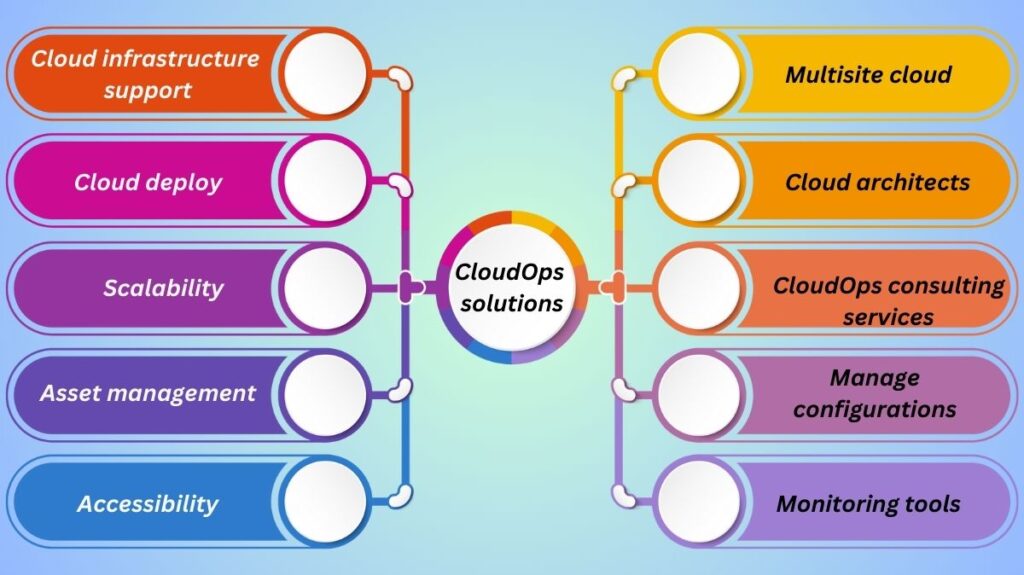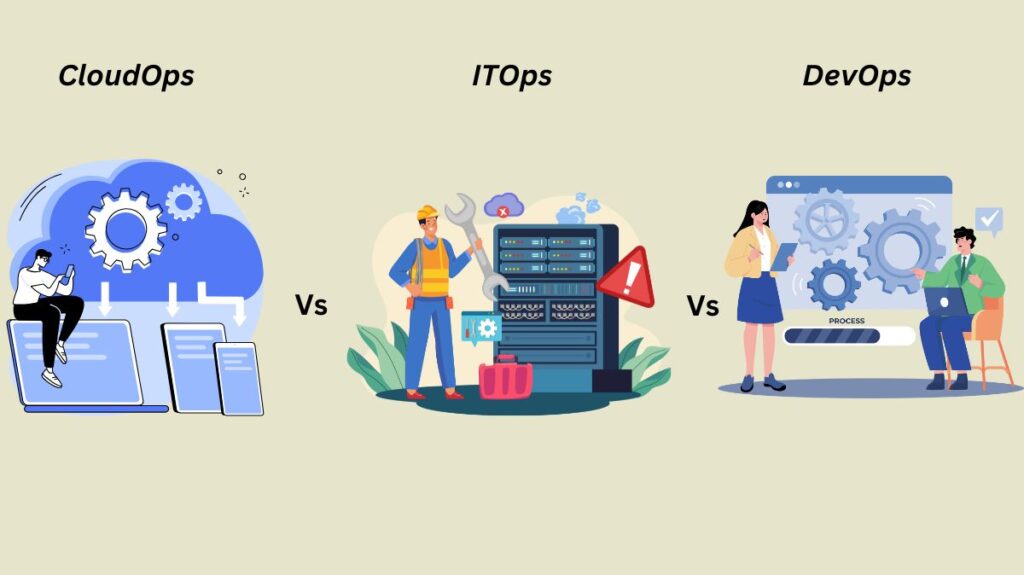Cloud operations is also known as CloudOps
CloudOps solutions

A group of tools and processes known as CloudOps (Cloud Operations) that assist companies in managing their cloud services and infrastructure. Among the CloudOps solutions are:
- Cloud infrastructure support: Assists in maintaining cloud-native infrastructure and applications.
- Cloud deployment: Assists in capacity regulation without requiring extra hardware.
- Scalability: Assists in controlling capacity without requiring extra hardware.
- Asset management and resource allocation: Effective resource allocation and asset management are made possible by this.
- Accessibility: Assists engineers and architects in overseeing and managing the cloud.
- Multisite cloud: Assists businesses in selecting the best cloud services.
- Cloud architects: Assist businesses in making sure their cloud infrastructure aligns with their objectives.
- CloudOps consulting services: Assists businesses in optimizing the advantages of cloud technologies.
- Manage configurations and compliance: Assists businesses in managing service-level agreements, configurations, and compliance.
- Monitoring tools: Assists businesses in keeping an eye on their cloud services.
CloudOps solutions assist businesses in making sure their cloud infrastructure aligns with their objectives. Additionally, they can assist businesses improve security and compliance, streamline processes, and spur expansion.
Which CloudOps best practices exist?
These procedures should be taken into account by organizations wishing to implement a CloudOps function:
Establish a migration strategy
Every workload will have different needs, and the use of micro-services and containerized apps may impose more limitations on the design of specific solutions. For instance, whether desired or not, a microservices-based application may need access to services across several clouds, necessitating a multi-cloud strategy. Other applications could need to use particular cloud providers to keep data in a particular location or to utilize a particular provider’s features, while other workloads might access sensitive data that needs to stay on-premises in a private cloud due to regulatory or governance mandates.
Include all stakeholders
Many departments and organizations are resistant to change, and cloud migration is no exception. To help make sure that business-critical activities don’t get lost during the migration, all stakeholders from users to senior executives should be involved in the planning process. Stress the value of adopting a CloudOps strategy and highlight how it complements current DevOps tactics.
Emphasize security
Although the cloud has many advantages, it also gives hackers and other bad actors a new attack surface or several attack surfaces to try to get past the organization’s defenses. In order to prevent minor issues from becoming into costly data breaches, start by implementing a zero-trust security approach, end-to-end encryption, and automated security monitoring and cleanup.
Automate to accelerate
Use non-disruptive automation tools and agile cloud workflows with plenty of self-service features, such as password resets and provisioning. Keep in mind that moving to the cloud is a continuous process; as the weeks and months go by Process, infrastructure, and connectivity areas that might significantly affect operations and monthly cloud expenses will be identified by CloudOps.
Include training in the plan
The skill set needed for cloud administration can differ greatly from that needed for on-premises data centers. New troubleshooting, provisioning, and deployment abilities take the role of the necessity for physical device maintenance. To assist guarantee that all the necessary skills are available when needed in a labour market that is tight, it could be advantageous to train current team members prior to the relocation.
Start small
Choose an application to migrate that can show all stakeholders the feasibility of a large-scale cloud migration and give proof-of-concept for both operations and user teams.
Develop the technique of storing configuration information, such as server definitions, in an infrastructure code model to provide quick expansion and instance deployment, scaling as needed. Since this will grow into an operating map of dependencies for all operations, make sure that the first and every application that is migrated has a clear explanation of the tools, services, and data needed for successful operation.
How is CloudOps similar to other operations processes?
CloudOps shares many of the same principles as DevOps, SecOps, and NetOps, which each explain the technologies, procedures, and operational methods used to govern a particular area of operation.
Multilayered CloudOps framework
A comprehensive framework for overseeing every facet of a company’s cloud ecosystem is called CloudOps. A governance layer, an application layer, an operation layer, a foundation layer, and a security layer that connects the others are the general layers into which this structure is typically divided.
Governance layer
Data security, compliance standards, business motivations and requirements, and actual risk are all covered by the governance layer’s operations. Cloud financial management, cloud operations management, cloud data management, and cloud security and compliance management are the main areas of activity.
Cloud application layer
The cloud application layer, located at the top of the tech stack, deals with how the company installs, maintains, and keeps an eye on apps and services unique to each application in the cloud.
Cloud operation layer
By deploying, managing, monitoring, and running cloud services, the cloud operation layer assists the application layer.
Cloud foundation layer
Identity, network management, logging, central backup management, infrastructure as code (IaC), and central monitoring are among the basic services provided by the cloud foundation layer, which underpins the application and operations layer.
Security layer
In order to assist guarantee that the system is not susceptible to threats, the security layer extends beyond all other layers. The CloudOps security layer should ideally be incorporated into the organization’s broader cybersecurity initiatives.
CloudOps providers
CloudOps may make use of hundreds of tools from dozens of suppliers. Ironically, limiting the amount of tools needed to achieve high availability in the cloud is a hurdle for administrators.
The majority of public cloud providers, such as AWS, Microsoft Azure, Google Cloud, and IBM, provide their clients with CloudOps capabilities. To automate configuration management, cloud provisioning, and application deployment, network engineering teams can also employ open source tools like Ansible or Chef in addition to commercial products from Apigee or Flexera, previously RightScale.
What is the difference between CloudOps, ITOps, and DevOps?

| Aspect | CloudOps | ITOps | DevOps |
|---|---|---|---|
| Definition | Management of cloud infrastructure and services to ensure optimal performance and scalability. | Administration of IT services and infrastructure for reliability, efficiency, and security. | Integration of development and operations to streamline the software lifecycle. |
| Primary Goal | Optimize and automate cloud resource usage for performance and cost-efficiency. | Ensure IT systems are operational, secure, and reliable. | Accelerate software development, delivery, and deployment. |
| Key Activities | Monitoring, managing, and scaling cloud environments. | Overseeing hardware, software, and network infrastructure. | Building, testing, deploying, and monitoring applications. |
| Automation Focus | Automated cloud provisioning, scaling, and optimization. | Automated IT infrastructure monitoring and maintenance. | Continuous integration, delivery, and deployment (CI/CD). |
| Tools and Practices | Uses cloud-native tools like Kubernetes, Terraform, and AWS CloudWatch. | Utilizes IT management tools like Nagios, Splunk, and ServiceNow. | Leverages CI/CD tools like Jenkins, Docker, and GitHub Actions. |
| Collaboration | Involves users, cloud providers, and IT teams. | Involves IT teams, management, and business stakeholders. | Encourages close collaboration between developers and operations teams. |
| Performance Goals | Ensures high availability, scalability, and security of cloud systems. | Guarantees uptime, performance, and security of IT systems. | Ensures software quality, performance, and rapid delivery. |
| Business Impact | Reduces operational costs, optimizes cloud resources, and accelerates service delivery. | Mitigates risks, maintains system reliability, and supports overall IT stability. | Boosts innovation, enhances time-to-market, and improves software quality. |
Read more on CloudOps Definition, Simplifying Cloud Control With CloudOPs
Read more on CloudOps Automation: Optimize Cloud Services, Infrastructure
